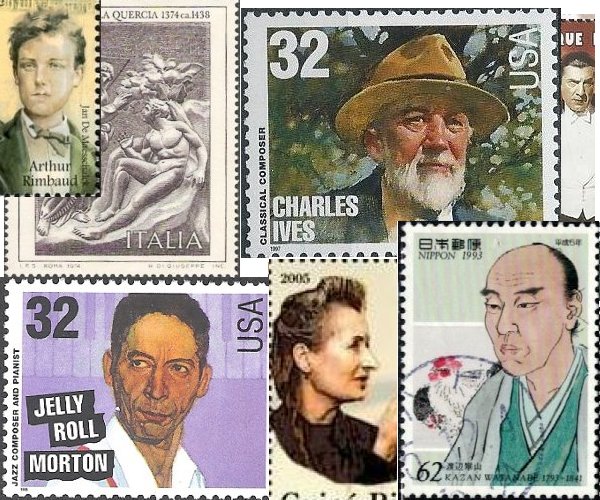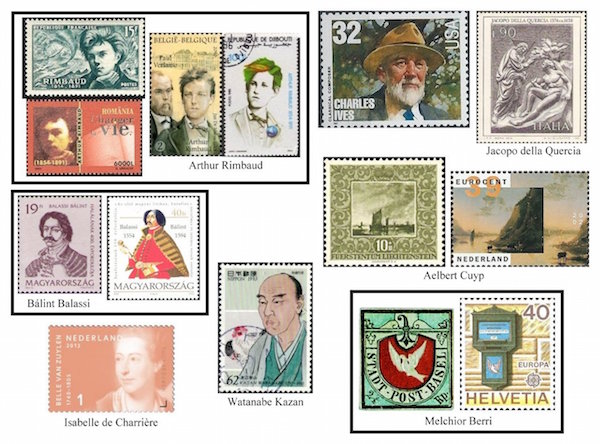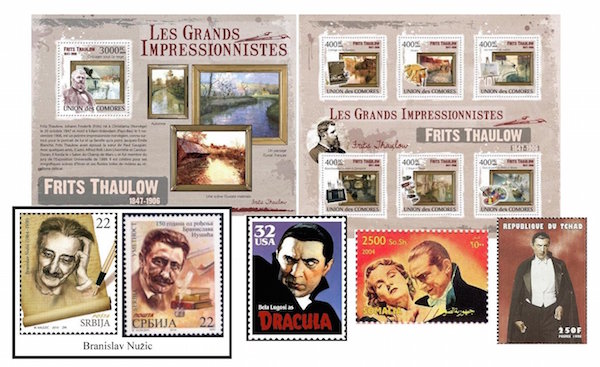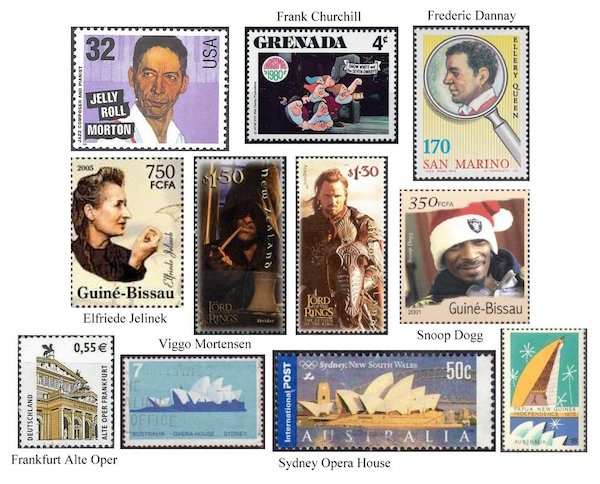The Arts on Stamps of the World —October 20
An Arts Fuse regular feature: the arts on stamps of the world.

By Doug Briscoe
It’s an avalanche of artists on today’s slopes, with Arthur Rimbaud and Charles Ives making the greatest seismic impact. From music we have Jelly Roll Morton and Snoop Dogg, from Hollywood Bela Lugosi and Viggo Mortensen, from literature Nobel Prize laureate Elfriede Jelinek and “Ellery Queen”. Beyond that, eight more birthdays, one death anniversary, and salutes to two opera houses! On a decidedly somber note, three of our subjects today were suicides.
The stunning poetry of Arthur Rimbaud (20 October 1854 – 10 November 1891) has been set by Benjamin Britten (Les Illuminations, 1939) and Hans Werner Henze (Being Beauteous, 1963), as well as Hendrik Andriessen, Paul Hindemith, Lee Hoiby, Hans Krása, Darius Milhaud, Bernard Rands, and the late Einojuhani Rautavaara, among others. Dinu Lipatti composed a song to Rimbaud’s “Sensation” (“Par les soirs bleus d’été, j’irai dans les sentiers“). At least two films have been made about Rimbaud’s life, dealing mainly with his love affair with Paul Verlaine, an Italian one from 1971, Una stagione all’inferno (A Season in Hell) with Terence Stamp, and Agnieszka Holland’s Total Eclipse (1995) with Leonardo DiCaprio and David Thewlis. The stamps are from France, Belgium, Romania, and Djibouti.
Although Charles Ives (October 20, 1874 – May 19, 1954) is regarded by many as the greatest American composer, I confess that with a few exceptions I have seldom been able to find his music rewarding. I remember introducing one of his marches on the air with the words, “Beware the marches of Ives.” I do quite like the 1982 recording made by Boston’s own Dan Stepner and pianist John Kirkpatrick of all five of the Ives Violin Sonatas.

Our sole non-birthday boy today is Italian sculptor Jacopo della Quercia, born around 1374, who died on this date in 1438. His work, heavily influenced by Roman antiquities and Donatello, bridges the Gothic and Renaissance styles. He was born near Siena, his father a woodcarver and goldsmith, and did work for the cathedrals of Lucca and Ferrara, as well as in other cities. He created a splendid new fountain for Siena in 1406; the original statues were removed and replaced with copies in 1858. His finest work is held to be the Porta Magna of the San Petronio church in Bologna. Della Quercia worked on this project (among others) for the last thirteen years of his life. One panel from this door, God admonishing Adam, appears on the postage stamp from 1974.
The lyric poet Bálint Balassi (BAW-lawsh-she; 20 October 1554 – 30 May 1594) is of central importance to Hungarian literature. As a nobleman—his full moniker was Baron Bálint Balassi de Kékko et Gyarmat—he was also a courtier and soldier. He died of a mortal leg wound received during a siege. His first literary effort was a translation of a German religious tract written to offer comfort to his exiled father. Fluent in multiple languages, Latin, Italian, German, Polish, Turkish, Slovak, Croatian, and Romanian, he is credited with being the founder of modern Hungarian lyric and erotic poetry, and a nine-line strophe is named for him. He also wrote hymns and patriotic and martial songs. The erotic lyrics are the most admired but remained unpublished until 1874.
Dutch landscape painter Aelbert Cuyp (October 20, 1620 – November 15, 1691) is the most famous member of his artist family. Born and died in Dordrecht, he excelled at capturing light in his expansive views of the Dutch countryside. The old 1951 stamp from Liechtenstein purports to show a Cuyp painting called Canal, but I can’t the find an image of the original online. The much newer Dutch stamp from 2002 shows Riverbank with Cows.
Another artist from the same country but from the next century is the writer Isabelle de Charrière (20 October 1740 – 27 December 1805), known as Belle van Zuylen in the Netherlands. Author of novels, plays, pamphlets, and letters, in later life she was also something of a composer. She was afforded an unusually broad education compared to that of other women of her time and, unbeknownst to her parents, published her first novel, Le Noble, in 1763. When they learned that the anonymous author of this satire of the nobility was their daughter, they had the book removed from sale. Born Isabella Agneta Elisabeth van Tuyll van Serooskerken, she numbered Johnson’s biographer James Boswell among her suitors, but married her brother’s tutor de Charrière in 1771 and lived the latter half of her life in Switzerland. She corresponded with Boswell for years, and they even collaborated on a novel. Her deep interest in music was lifelong. She at one point wrote an opera libretto and sent it to Mozart, but we don’t know whether he responded. In 1790 de Charrière began studying composition herself with Niccolò Zingarelli and left a small body of works including nine piano sonatas, a set of six minuets for string quartet, and ten airs and romances. The portrait on the stamp is that by Jens Juel, dated 1777.

The Japanese painter Watanabe Kazan (October 20, 1793 – November 23, 1841) also acted as a senior councilor to a local lord on the south coast of Japan. Born Watanabe Sadayasu in Edo to a poor family of the samurai class, he evinced artistic talent in childhood. Western art had a strong influence on his work, for example, in respect of shading effects in his portraits. Watanabe straddled both worlds, a traditional Confucian, upholding strict conventions of honor and loyalty to his lord, while at the same time fascinated by Western political and scientific developments. He fell under a cloud with writings perceived as critical of the Shogun and ultimately committed seppuku to atone for the embarrassment he had caused his lord. The stamp shows a detail from a posthumous portrait of 1853, and I link to a couple of the artist’s own works, Surimono, A court lady seated at a koto in a room open to the garden (1828) and Portrait of Ichikawa Beian (1837).
The odd philatelic fact about Swiss architect Melchior Berri (20 October 1801 – 12 May 1854) is that while there do not appear to be any stamps showing his buildings, there are two representing his efforts on a much smaller scale. The son of a pastor in Basel, he studied architecture in Karlsruhe and Paris, learning more from his visit to Rome and Pompeii in 1826. Back in Basel, he started a construction business and a school. His only remaining substantial building is the city’s Museum for Natural History and Ethnography (1842-49). In the midst of this project, pivoting from the immense to the infinitesimal, Berri designed the world’s first tricolor stamp! It was a local issue for the canton of Basel, predating the national Swiss stamps by five years. The stamp, called the Basel Dove, the only one ever issued by the canton, came out on 1 July 1845 and was valid until 30 September 1854. Over 41,000 were issued, and you can pick one up for a book price of about $11,000. Or you can just look at the image I posted. As a member of the city council, Berri was it seems also responsible for designing public mail boxes, one example from 1845 being shown on a Swiss stamp of 1979. Overworked, depressed, and perhaps disappointed in his aspirations for an international reputation, Berri took his own life at the age of 52.
Coincidentally, our next artist, the Norwegian Impressionist painter Frits Thaulow (20 October 1847 – 5 November 1906) also studied in the German city of Karlsruhe, though he attended the Academy of Art in Copenhagen first. He was one of the earliest artists to paint in the Skagen area, before it became a colony for artists. Thaulow assisted in the establishment of Denmark’s first National Art Exhibit in 1882. Ten years later he relocated to France, where he remained for the rest of his life. Less interested in Parisian cityscapes, he found satisfaction in painting scenes in small towns. A pair of sheets from the Comoros Islands offers a total of ten canvases, for which I found links to the following: from the sheet at left, Cottages in the Snow (1891; this is at the MFA, with a half dozen other Thaulow pieces), Autumn, A French River Landscape, and A Morning River Scene (1891); and from the right-hand sheet of six, Marble Steps (Marmortrappen, at upper right, 1903) and, at lower left, Washerwomen at Quimperle. Not shown on any of the stamps, but too lovely to let slip by, is Moonlight in Beaulieu (1904). Harvard’’s Busch-Reisinger Museum houses The Watermill (c1900).

In some circles Serbian writer Branislav Nušić (NU-shitch; 20 October [O.S. 8 October] 1864 – 19 January 1938), author of plays, novels, and essays, is thought of as the Serbian and Balkan Gogol. Born Alkibijad Nuša in Belgrade, he is also referred to in Aromanian as Alchiviadi al Nusa and in Greek as Alcibiades Nousias. Nušić is not merely a pseudonym, however, as he legally changed his name in 1882, when he was 18. Hardly had he earned his law degree when he was drafted into the Royal Serbian Army just in time to be involved in the two-week-long Serbo–Bulgarian War of November 1885. That very year he criticized the Serbian Supreme Command in a book that didn’t, it seems, get him into hot water, but a poem he wrote two years later did. It mocked the King of Serbia and earned him a year in prison. On his release he entered the diplomatic service, later working at the Ministry of Education and as head of the national theaters in Belgrade and Novi Sad. Always a political activist, Nušić turned to journalism as a writer and editor and spoke out publicly in opposition to Austria-Hungary’s annexation of Bosnia and Herzegovina in October 1908. This increased his popularity enormously. After the First Balkan War, when Macedonia was annexed by Serbia, he was named prefect of Bitola and helped found the first theater in Skopje, which he would later direct. He lost his only son in World War I and, following the Royal Serbian Army’s 1916 retreat, in which he personally took part, he lived in Italy, Switzerland, and France for the rest of the war. His plays, which are regarded as his most important works, addressed issues of Serbian middle-class society.
The original pronunciation of Bela Lugosi (1882 – 16 August 1956) would have been BAY-la LU-go-shee, but that wasn’t his real name anyway. He was born Béla Ferenc Dezső Blaskó in the town from which he took his stage name, Lugos (LU-gosh), now Lugoj in Romania. He served in the infantry in World War I, rose to captain, and was wounded while fighting the Russians. On his discharge in 1916 he resumed working on the stage and appeared in his first film in 1917. Lugosi was active in the actors’ union, a fact that led him to flee the country in 1919. From Germany, where he made some more movies, he came to the United States, working as a seaman on a merchant ship and entering at New Orleans in December 1920. He became a citizen in 1931, the year of his role in Tod Browning’s Dracula. Unable to break free of his horror-movie typecasting and addicted to the morphine and methadone he took for his sciatic neuritis, he came in his later years to a sad end, forced to accept roles in howlers like Ed Wood’s notorious Plan 9 from Outer Space. Incidentally, one of Lugosi’s fellow actors in that picture was Tor Johnson (born Tore Johansson), whose birthday was yesterday (19 October 1902 – 12 May 1971). Even on postage stamps, Lugosi can’t seem to escape the curse of Dracula.
I must have led a sheltered life, because until now I never knew that the phrase “Jelly Roll” was, according to Wikipedia, “African-American slang for female genitalia, and by extension a lover of same.” The nickname became attached to Ferdinand Joseph LaMothe (October 20, 1890 – July 10, 1941) because, like the young Brahms, he was playing piano in a whorehouse in his teens. In order to keep disgrace from his family, he told his church-going great-grandmother that he was working night shifts in a barrel factory and, as an extra precaution, took on a different last name, and so it is that Ferdinand LaMothe became Jelly Roll Morton. Born in New Orleans, he played ragtime and wrote the first published jazz composition, “Jelly Roll Blues” (1915), later claiming to have invented jazz as early as 1902.
We tip our hat to American film composer Frank Churchill (October 20, 1901 – May 14, 1942), who wrote most of the music for Disney’s Snow White and the Seven Dwarfs (1937), including the songs “Heigh-Ho” and “Whistle While You Work”. He also shared an Oscar with Oliver Wallace for the score of Dumbo (1941). Churchill was born in Rumford, Maine and began his career playing piano, not in brothels, but in cinemas at the age of 15 (a year older than Jelly Roll Morton). He was an accompanist at a Los Angeles radio station in 1924 and went to work for Disney in 1930, where he scored many animated shorts. After Snow White he was promoted to supervisor of music for the studio at Disney. Like Watanabe Kazan and Melchior Berri, Frank Churchill committed suicide, the cause perhaps being the deaths of two very close friends and colleagues within a month of each other that same year. From the inordinate plethora of Disney stamps issued with abandon the world over, I chose one from a Grenadan set devoted to Snow White and the Seven Dwarfs.
Also born on an October 20th was Daniel Nathan (1905 – September 3, 1982), who used the pen name Frederic Dannay. With his cousin Emanuel Lepofsky, aka Manfred Bennington Lee (January 11, 1905 – April 3, 1971), he was the creator of Ellery Queen. Not only did the Brooklyn-born cousins write a long series of novels featuring the character, but they also founded Ellery Queen’s Mystery Magazine (Dannay was much the more active force there, serving as directing editor) and collaborated on a valuable thousand-page anthology, 101 Years’ Entertainment: The Great Detective Stories, 1841–1941. The stamp from San Marino depicts neither Dannay nor Lee but an artist’s conception of the detective. In a memorable quip, British mystery writer Margery Allingham wrote that Ellery Queen had “done far more for the detective story than any other two men put together.”
A writer of a very different stripe is the Austrian playwright and novelist Elfriede Jelinek (born 20 October 1946), who won the Nobel Prize in 2004. Born in Styria to a Romanian-German Catholic mother and Czech Jewish father, she was reared in Vienna. Her mother had high hopes for her as a musician, and Elfriede was taught piano, organ, guitar, violin, viola, and recorder and studied at the Vienna Conservatory. It was only as the consequence of an anxiety disorder that Jelinek turned to literature as a form of therapy. Her first published work was a poetry collection, Lisa’s Shadow (Lisas Schatten, 1967). Her work, which has focused on issues of feminism, anti-consumerism, and anti-fascism (many of her relatives were lost in the Holocaust), has been highly varied: plays for radio and film, an opera libretto, novels, poetry, polemical essays, and so on, and she has translated plays from the French and English (Christopher Marlowe, Oscar Wilde), as well as Thomas Pynchon’s novel Gravity’s Rainbow and a number of stories and poems by Latin American authors. Her own novel The Piano Teacher was made into the Michael Haneke film of the same name (2001) starring Isabelle Huppert.
American actor Viggo Mortensen Jr. (born October 20, 1958) is active in various other arts as well, as multilingual poet, musician, photographer, and painter. As for film, he made his first appearance in the Peter Weir thriller Witness (1985) and is a fantasy favorite for his role of Strider/Aragorn in the Lord of the Rings films. (It is in those guises that he appears on two New Zealand stamps.) In the meantime he has performed in such other fine pictures as A History of Violence (2005), Appaloosa (2008, a darn good Western, I think), and A Dangerous Method (2011), for which he received a Golden Globe. As for music, he’s made a fair number of albums, often in collaboration with guitarist Buckethead, and wrote and sang the song “Aragorn’s Coronation” (to words by Tolkien) for The Return of the King. As for a sample of his painting, here’s a link to After Darkly Noon. Though born in New York City, Mortensen holds dual American and Danish citizenship and speaks fluent Danish, English, French, and Spanish with competence in Italian, Norwegian, and Swedish.
For the time being, Calvin Cordozar Broadus Jr. (born October 20, 1971) has adopted the stage name Snoop Dogg. This actually derives from a childhood nickname, but he has varied his performing name over time, from the original Snoop Doggy Dogg to Snoop Lion (2012), etc. (Moreover, Broadus is his stepfather’s name, Snoop’s birth name having been Varnado.) The Long Beach-born rapper has also acted in TV and film, including Bollywood, and has diversified as a record producer and entrepreneur with a line of cannabis products, Leafs By Snoop.
Finally for today, two opera houses both opened on the 20th of October in different years: the Frankfurt Alte Oper in 1880 and the Sydney Opera House in 1973.
Too bad Tom Petty (October 20, 1950 – October 2, 2017) missed his birthday by eighteen days.
A graduate of the University of Massachusetts with a B.A. in English, Doug Briscoe worked in Boston classical music radio, at WCRB, WGBH, and WBUR, for about 25 years, beginning in 1977. He has the curious distinction of having succeeded Robert J. Lurtsema twice, first as host of WGBH’s weekday morning classical music program in 1993, then as host of the weekend program when Robert J.’s health failed in 2000. Doug also wrote liner notes for several of the late Gunther Schuller’s GM Recordings releases as well as program notes for the Boston Classical Orchestra. For the past few years he’s been posting a Facebook “blog” of classical music on stamps of the world, which has now been expanded to encompass all the arts for The Arts Fuse.
